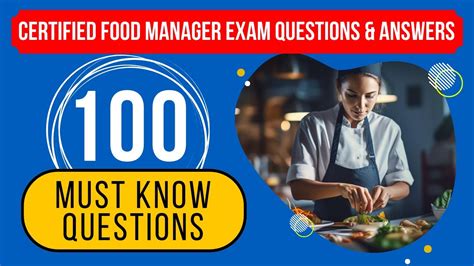Introduction
The food industry is a fast-paced and ever-changing environment where food safety is paramount. Food managers play a crucial role in ensuring that food is handled and prepared safely, preventing foodborne illnesses and protecting public health. Passing the food manager certification exam is a valuable step towards demonstrating your knowledge and commitment to food safety. This practice test will provide you with a comprehensive overview of the core concepts and best practices covered in the exam.

Core Concepts
Food Safety Hazards
- Physical hazards (e.g., bones, glass, metal fragments)
- Chemical hazards (e.g., cleaning agents, pesticides)
- Biological hazards (e.g., bacteria, viruses, parasites)
Foodborne Illnesses
- Types of foodborne illnesses (e.g., Salmonella, E. coli, norovirus)
- Symptoms and treatment
- Prevention strategies
Food Handling and Preparation Practices
- Personal hygiene
- Proper handwashing techniques
- Safe food storage and preparation
- Cross-contamination prevention
Facility Sanitation and Maintenance
- Cleaning and disinfection procedures
- Pest control
- Equipment maintenance
Practice Questions
1. Which of the following is NOT a physical hazard associated with food?
(a) Bones
(b) Glass
(c) Bacteria
(d) Metal fragments
2. What is the minimum internal cooking temperature for poultry to ensure safety?
(a) 145°F
(b) 155°F
(c) 165°F
(d) 175°F
3. Which of the following is NOT a symptom of a foodborne illness?
(a) Fever
(b) Vomiting
(c) Sore throat
(d) Diarrhea
4. What is the proper temperature for holding cold food?
(a) 32°F or below
(b) 38°F or below
(c) 41°F or below
(d) 45°F or below
5. Which of the following is NOT a method for preventing cross-contamination?
(a) Using clean utensils and equipment
(b) Separating raw and cooked foods
(c) Washing produce thoroughly
(d) Using the same cutting board for all foods
Answers
- c
- c
- c
- a
- d
Step-by-Step Approach to Food Safety Management
1. Identify Hazards: Conduct a thorough assessment of your food establishment to identify potential hazards.
2. Control Hazards: Implement measures to eliminate, reduce, or prevent hazards, such as safe storage practices, proper cooking techniques, and employee training.
3. Monitor and Verify: Regularly monitor your food safety system to ensure that it is working effectively. This includes temperature checks, microbial testing, and employee inspections.
4. Maintain Records: Keep accurate records of all food safety activities, including employee training, cleaning logs, and any incidents or corrective actions.
Frequently Asked Questions (FAQs)
1. What are the benefits of becoming a certified food manager?
- Demonstrates commitment to food safety
- Improves restaurant reputation
- Reduces the risk of foodborne illnesses
- Meets regulatory requirements
2. How long is the food manager certification valid?
- Typically 3-5 years, depending on the issuing authority
3. Where can I take the food manager certification exam?
- Contact your local health department or accredited testing organizations
4. What resources are available to help me prepare for the exam?
- Study guides
- Online courses
- Practice tests
5. What is the minimum score required to pass the exam?
- Typically 70-80%, depending on the testing authority
6. What are the consequences of failing the exam?
- You will need to retake the exam to obtain certification
Conclusion
Passing the food manager certification exam is a valuable step towards ensuring the safety of food in your establishment. By understanding the core concepts and best practices outlined in this practice test, you can prepare yourself to effectively manage food safety and protect your customers. Remember to apply the step-by-step approach and utilize available resources to continuously improve your food safety system.
